By Haroon Janjua
Economic pundits and institutions around the World are estimating the financial and strategic impacts of TPP on Pacific members generally, and on the U.S. particularly on the long run over economic rivalry with the China
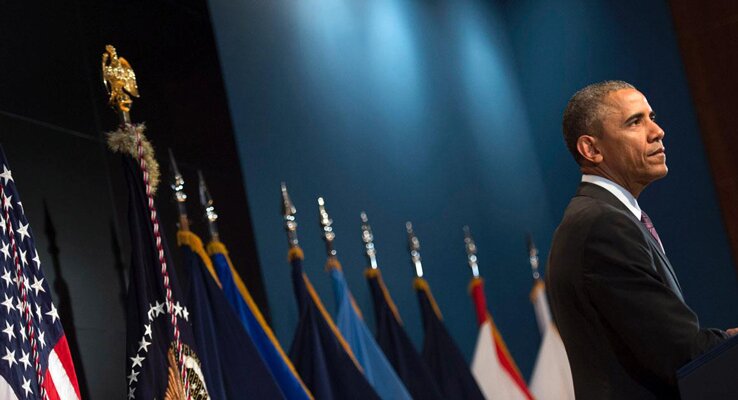
Last month, the vote in the senate cast a long shadow on Trade Promotion Authority, also called “Fast Track”, the legislation that guarantees efficient transition of regulation by the U.S. congress to ascertain TPP and the other trade agreements. The enactment of fast track legislation entails that Congress cannot amend the concluding trade deal but can only vote for final approval. However, recently the U.S. and the Japan media reports suggests that TPP representatives have set a last round of talks later this month with a goal to reach a broad agreement on ambitious trade accord.
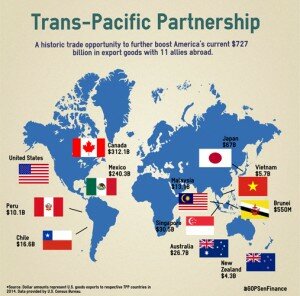 Economic pundits and institutions around the World are estimating the financial and strategic impacts of TPP on Pacific members generally, and on the U.S. particularly on the long run over economic rivalry with the China. For example, Peterson Institute for International Economics found that if this deal is finalized the U.S. economy will boost extravagantly and expect to reach over $77 billion increase in the income by 2025.
Economic pundits and institutions around the World are estimating the financial and strategic impacts of TPP on Pacific members generally, and on the U.S. particularly on the long run over economic rivalry with the China. For example, Peterson Institute for International Economics found that if this deal is finalized the U.S. economy will boost extravagantly and expect to reach over $77 billion increase in the income by 2025.
However, renowned economists Joseph Stiglitz and Paul Krugman have indicated that the deal as a matter of fact would give minimal economic gains for the US, even for the financial and corporate interests that continue to achieve maximum from regulatory liberalizations.
TPP Primer
The TPP is the most significant trade accord ever conceived between the U.S-Canada and the Asia-Pacific region. If the agreement could be finalized then it could be the first “mega-regional” of its kind. This giant free trade deal constitutes the U.S., Canada and 10 countries of the Asia-Pacific region Australia, Brunei, Chile, Malaysia, Mexico, New Zealand, Canada, Peru, Singapore, Vietnam and most critically Japan. These countries represent the 40 percent of the global output and 25 percent of the global exports of goods and services. These countries are like-minded in their interests and priorities of quality trade and investment agenda with different precedence, which shows that negotiations have not been simple.
 The European Commission portrays the EU as the “gigantic economy in the world”; however the new Pacific trade zone would represent a larger percentage of the world’s GDP, imports and exports. Asia deemed fundamental importance to the U.S. trade and security interests. As indicated by the U.S. Trade representative, the Asia-Pacific region is central driver of the world economic growth beside absence of the China,—the Asia’s biggest economy.
The European Commission portrays the EU as the “gigantic economy in the world”; however the new Pacific trade zone would represent a larger percentage of the world’s GDP, imports and exports. Asia deemed fundamental importance to the U.S. trade and security interests. As indicated by the U.S. Trade representative, the Asia-Pacific region is central driver of the world economic growth beside absence of the China,—the Asia’s biggest economy.
The shifting of the U.S. strategy to Asia i.e. “Pivot to Asia” in 2011, to strengthen diplomatic, economic and strategic resources with Asia and among this strategy the TPP remains at the economic heart of the pivot. The Asian economy accounts for almost 60 percent of the global GDP and more or less 50 percent of the international trade. Since 1990, Asia Pacific commodities trade has expanded 300 percent while there has been a steady 400% increase in the global investment across the region. On the basis of these facts the U.S. has pursued its bilateral regional trade interests and through multilateral groupings for example APEC, which has connected the Western Hemisphere with Asia since 1989.
Multiple Disputes
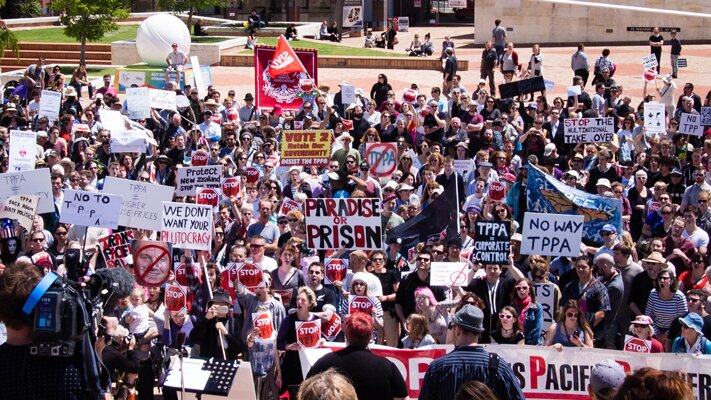 Apparently the TPP looks like normal trade deal but right from the beginning it has multiple disputes and serious concerns among the member countries. As indicated from the several sessions beyond conclusive negotiations, the TPP embarks to fortify a higher rate of economic development in the U.S. and among its Pacific friends. The U.S. is not merely considering it a treaty but a potential pillar of its long term strategy for years to come.
Apparently the TPP looks like normal trade deal but right from the beginning it has multiple disputes and serious concerns among the member countries. As indicated from the several sessions beyond conclusive negotiations, the TPP embarks to fortify a higher rate of economic development in the U.S. and among its Pacific friends. The U.S. is not merely considering it a treaty but a potential pillar of its long term strategy for years to come.
The countries are coming up to the most critical issues in the last leg of negotiations. If the leaders could reach to resolve sticking points by August 2015, then the Congress could legislate by the end of this year in an ideal scenario.
Prominent controversies in the negotiations include access to agricultural markets in Canada, while Australian worries existing over U.S. pharmaceutical industry, China factor in the exports of Vietnam textile and labor rights both in Vietnam and Mexico. The disagreement regarding access to Canada’s ensured dairy and poultry markets is so intense that few members say they believe Canada could drop out of the negotiations.
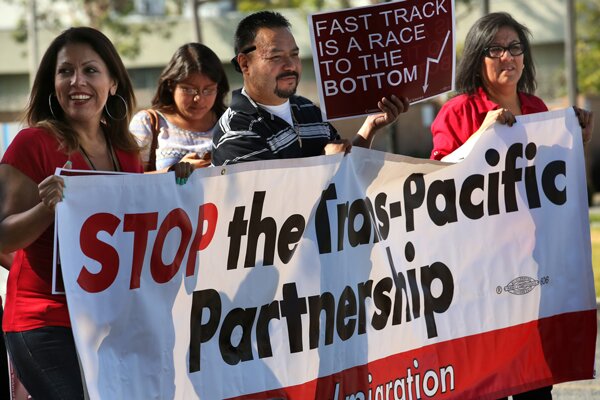 Recently a UN expert panel have criticized to the possibly detrimental impact of the TPP accord, indicating that the deal’s provisions provide immensely to the business activities of pharmaceutical cartel.
Recently a UN expert panel have criticized to the possibly detrimental impact of the TPP accord, indicating that the deal’s provisions provide immensely to the business activities of pharmaceutical cartel.
This massive trade zone expanding from Canada and Chile to Australia and Japan would be a milestone for president Obama who is willing to achieve it. At the various occasions, Mr. Obama repeatedly promised to deliver the most dynamic trade accord in the history.
Australia and New Zealand have challenged U.S. request connecting the agreement’s intellectual property protections with patent decides that could moderate the selection of non specific medications in their countries national health projects.
Japan’s decision to fall in the talks in 2013 gave the suggested accord immense economic heft. However, recently the U.S. and Japan, over disputes like exceptional tariffs on agricultural products and automotive industry are still at odds but it is hoped that both the countries will pave the way to reach an agreement in the end of July. In addition the TPP members are in a state of argufy over intellectual property rights, state-owned enterprises, labor and environment standards and investor-state dispute settlement.
The China Factor
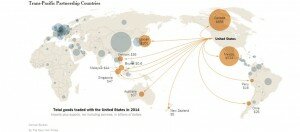 After the formation of Asian Infrastructure Investment Bank (AIIB) by China, which has been supported by 49 countries from Europe, Africa, South America and Oceania imposing serious economic threats to the U.S, the reason to finalize TPP immediately is due to the pressure mounted by China to challenge the U.S. economy. It also signals that China is increasingly willing to set up alternative, rival institutions to the organizations that the U.S. has backed since the end of WWII.
After the formation of Asian Infrastructure Investment Bank (AIIB) by China, which has been supported by 49 countries from Europe, Africa, South America and Oceania imposing serious economic threats to the U.S, the reason to finalize TPP immediately is due to the pressure mounted by China to challenge the U.S. economy. It also signals that China is increasingly willing to set up alternative, rival institutions to the organizations that the U.S. has backed since the end of WWII.
Described as a “comprehensive trade pact that could help cement our dominance over China in Asia” by a prominent American columnist, Senator Charles E. Schumer claimed the deal’s stated goal is to “lure” other countries “away from China”. If the underlying geopolitics of the deal weren’t clear enough, President Obama himself claimed, “If we don’t write the rules, China will write the rules,” in an interview with the Wall Street Journal. Needless to say, the TPP is no ordinary trade agreement.
If the TPP can change the trajectory of American power relative to China’s, it may be the single most important factor in whether the United States retains its “indispensable” role in the 21st Century.
Haroon Janjua is a freelance journalist based in Islamabad. He is 2014 International Green Apple Award winner. He tweets at @JanjuaHaroon
